“Venus” Steve Jobs and Laurene Powell Jobs’ Yacht in Sint Maarten
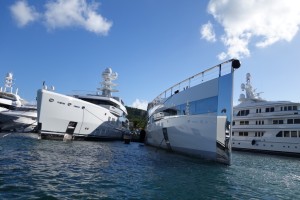 Venus is the $120M, 260 foot superyacht designed by Philippe Stark for Apple founder, Steve Jobs, and his wife, Laurene Powell Jobs. It was finished after the Steve Jobs’ death, but it has remained in his family and here it is in Simpson Bay, Sint Maarten, where we passed it, standing out among the other megayachts with unique elegance, the way Apple products do too.
Venus is the $120M, 260 foot superyacht designed by Philippe Stark for Apple founder, Steve Jobs, and his wife, Laurene Powell Jobs. It was finished after the Steve Jobs’ death, but it has remained in his family and here it is in Simpson Bay, Sint Maarten, where we passed it, standing out among the other megayachts with unique elegance, the way Apple products do too.
I’d rather be sailing, so I’ll take our Antares catamaran over Venus, but I wouldn’t mind having dinner on her sometime (if you’re reading, Laurene 🙂
Here is an excerpt of an article in Vanity Fair detailing more about Venus and the process of creating her.
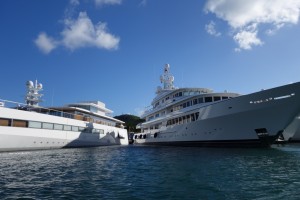 “….A blunder by a phone operator might have prevented the miracle from taking place and no one would have ever known about it. Philippe Starck still laughs at the thought. It was seven years ago, at the headquarters of his Parisian offices near the Place de la République. The employee had informed the famous French decorator that a Mr. Jobs had called. The young woman did not see who that might be—despite the fact that she probably had a Mac running in front of her and had been downloading music on her iPod for some time. Perhaps she had even seen Toy Story, the film that revolutionized animated features. Still, she had not made the connection with the founder of Apple, former owner of Pixar, the man who transformed technology into an object of desire and commerce. She had written down his name but had refused to disturb her boss. The caller, who had spoken English, hung up without leaving a number. “Can you imagine the aura of Jobs in 2007” chuckles Starck today. “He was basically God! And she doesn’t put him through because she didn’t know who he is! We were off to a good start.”
“….A blunder by a phone operator might have prevented the miracle from taking place and no one would have ever known about it. Philippe Starck still laughs at the thought. It was seven years ago, at the headquarters of his Parisian offices near the Place de la République. The employee had informed the famous French decorator that a Mr. Jobs had called. The young woman did not see who that might be—despite the fact that she probably had a Mac running in front of her and had been downloading music on her iPod for some time. Perhaps she had even seen Toy Story, the film that revolutionized animated features. Still, she had not made the connection with the founder of Apple, former owner of Pixar, the man who transformed technology into an object of desire and commerce. She had written down his name but had refused to disturb her boss. The caller, who had spoken English, hung up without leaving a number. “Can you imagine the aura of Jobs in 2007” chuckles Starck today. “He was basically God! And she doesn’t put him through because she didn’t know who he is! We were off to a good start.”
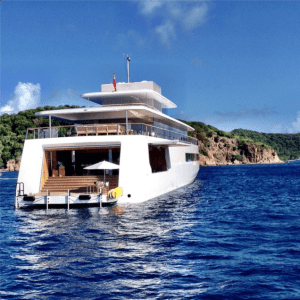 It was a miracle that the Californian divinity was not discouraged. “For anyone who knew Steve,” Starck adds, “he almost certainly wouldn’t call back after such a humiliation.” A few weeks after this, “God” was on line again. This time, the Parisian designer was just leaving for Milan, to the annual furniture trade show, a ritual meeting place for the experts of planet design. A half-dozen motorcycle taxis awaited him, as well as members of his team, with their engines running. He barely had enough time to make the flight to Italy where a multitude of press conferences had been scheduled—being late was not an option. “I already had my helmet on when the operator caught me, breathless,” he says. “Monsieur Starck! Monsieur Starck! You know that person, that Mr. Jobs? He wants to talk to you!” I took off my helmet and heard his voice: “Would you like to make me a boat?” “Well… sure,” I replied. The two men only exchanged but a few words: “Fifteen seconds” of conversation, confirms Philippe Starck. To the American billionaire’s direct question: “Will you know how?” he says he proudly replied, before blazing on to the airport, “Of course! I have palms in between my fingers and scales on my back. I am amphibian.”
It was a miracle that the Californian divinity was not discouraged. “For anyone who knew Steve,” Starck adds, “he almost certainly wouldn’t call back after such a humiliation.” A few weeks after this, “God” was on line again. This time, the Parisian designer was just leaving for Milan, to the annual furniture trade show, a ritual meeting place for the experts of planet design. A half-dozen motorcycle taxis awaited him, as well as members of his team, with their engines running. He barely had enough time to make the flight to Italy where a multitude of press conferences had been scheduled—being late was not an option. “I already had my helmet on when the operator caught me, breathless,” he says. “Monsieur Starck! Monsieur Starck! You know that person, that Mr. Jobs? He wants to talk to you!” I took off my helmet and heard his voice: “Would you like to make me a boat?” “Well… sure,” I replied. The two men only exchanged but a few words: “Fifteen seconds” of conversation, confirms Philippe Starck. To the American billionaire’s direct question: “Will you know how?” he says he proudly replied, before blazing on to the airport, “Of course! I have palms in between my fingers and scales on my back. I am amphibian.”
 The son of an engineer who designed airplanes, Starck spent a great part of his childhood admiring ships. At 15, he taught survival in the case of shipwreck at a sailing school in the bay of Morlaix, he and his brother also raced boats on the Seine. “I always had boats, whatever the size,” he told the quaterly Mer & Bateaux in 2012 . I always have one in the concept stage or the building stage. My wife and I have lived in places where we could have a boat moored in front of our house. We live on the water and for the water.” Famous for his hotel and restaurant designs all over the world —the Café Costes, the Mama Shelter hotel, the Meurice and the Royal Monceau in Paris, the Royalton in New York, the Mondrian in Los Angeles and the Fasano in Rio—Starck did not necessarily want to design yachts for anyone beside himself. In Starck Explications, a manifesto published in 2003 for the exhibition dedicated to his work at the Pompidou Center, he tells the story of a prank pulled on a client who wanted to commission him a yacht : he had advised him to first go for a swim to see whether he truly needed a boat! Later, a “gorgeous woman,” whose name he does not mention, made him a new offer (it was Hala Fares, the spouse of the businessman and Lebanese vice-premier minister Issam Fares) that he declined because he found the very idea of a yacht “structurally vulgar.” The lady, cunningly, defied him to build one that avoided vulgarity, and for her he designed Wedge Too. Six years later, in 2008, Starck conceived the A for Andrey Menichenko, the Russian oligarch. 119 meters long and weighing 6000 tons, it’s one of the greatest motor yachts ever made, and its cost was an estimated $300 million. Its aggressive form was the object of very lively criticism: in an article on January 23, 2008, the Wall Street Journal even wondered whether it wasn’t “the world’s ugliest boat.”
The son of an engineer who designed airplanes, Starck spent a great part of his childhood admiring ships. At 15, he taught survival in the case of shipwreck at a sailing school in the bay of Morlaix, he and his brother also raced boats on the Seine. “I always had boats, whatever the size,” he told the quaterly Mer & Bateaux in 2012 . I always have one in the concept stage or the building stage. My wife and I have lived in places where we could have a boat moored in front of our house. We live on the water and for the water.” Famous for his hotel and restaurant designs all over the world —the Café Costes, the Mama Shelter hotel, the Meurice and the Royal Monceau in Paris, the Royalton in New York, the Mondrian in Los Angeles and the Fasano in Rio—Starck did not necessarily want to design yachts for anyone beside himself. In Starck Explications, a manifesto published in 2003 for the exhibition dedicated to his work at the Pompidou Center, he tells the story of a prank pulled on a client who wanted to commission him a yacht : he had advised him to first go for a swim to see whether he truly needed a boat! Later, a “gorgeous woman,” whose name he does not mention, made him a new offer (it was Hala Fares, the spouse of the businessman and Lebanese vice-premier minister Issam Fares) that he declined because he found the very idea of a yacht “structurally vulgar.” The lady, cunningly, defied him to build one that avoided vulgarity, and for her he designed Wedge Too. Six years later, in 2008, Starck conceived the A for Andrey Menichenko, the Russian oligarch. 119 meters long and weighing 6000 tons, it’s one of the greatest motor yachts ever made, and its cost was an estimated $300 million. Its aggressive form was the object of very lively criticism: in an article on January 23, 2008, the Wall Street Journal even wondered whether it wasn’t “the world’s ugliest boat.”
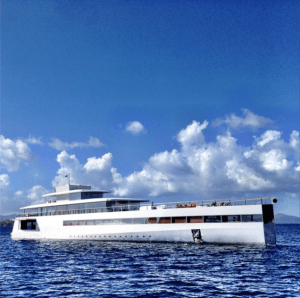 Moreover, Starck prides himself on helping save the Bénéteau ship yard in Vendée from bankruptcy by designing a line of sailboats for it, then conceiving a revolutionary single-rudder racer, Virtuelle, designed in 1997, for a very wealthy Italian (even though the plans are officially signed by a transalpine naval architect). According to Starck, ten years later, it was this sailboat, with its minimal lines, that Steve Jobs cited as an example to persuade him to work for him—“Virtuelle is the most beautiful boat I’ve seen in my life,” is what he told him (Mer & Bateaux, December 2012). Starck, who is not averse to tributes, and is prompt to quote this Rousseau sentence : “I would rather be a man of paradoxes than a man of prejudices,” took the compliment as a challenge. Jobs too had his contradictions. In 1995, after Pixar’s successful skylight public offering, he had said he “was not planning on buying a yacht.” But Venus was not going to be just any yacht.
Moreover, Starck prides himself on helping save the Bénéteau ship yard in Vendée from bankruptcy by designing a line of sailboats for it, then conceiving a revolutionary single-rudder racer, Virtuelle, designed in 1997, for a very wealthy Italian (even though the plans are officially signed by a transalpine naval architect). According to Starck, ten years later, it was this sailboat, with its minimal lines, that Steve Jobs cited as an example to persuade him to work for him—“Virtuelle is the most beautiful boat I’ve seen in my life,” is what he told him (Mer & Bateaux, December 2012). Starck, who is not averse to tributes, and is prompt to quote this Rousseau sentence : “I would rather be a man of paradoxes than a man of prejudices,” took the compliment as a challenge. Jobs too had his contradictions. In 1995, after Pixar’s successful skylight public offering, he had said he “was not planning on buying a yacht.” But Venus was not going to be just any yacht.
On April 28, 2007, Philippe Starck and his companion, Jasmine —he would marry her the following December—turned up in front of Steve Jobs residence in Palo Alto, California, in north Silicon Valley. The area seemed ordinary, the entrance gate did not look like much. A driver had taken them there after a twelve-hour flight between Paris and Los Angeles. Noting the modesty of the place, the French designer felt obliged to add : “We’re going to Steve Jobs’, you know, the head of Apple.” But the chauffeur did not turned around, it was the right address. “We got out. The gate in old ironwork was about a meter tall and there was a detail that struck me and pleased me, it closed with a plumbing jointure. I said to myself, “Wait, it might actually be here after all.” Starck opened it, crossed a “small yard,” knocked on the glass of what looked like a kitchen door. “It vibrated the way old tiles do. No one came but everything was open. Suddenly, a ghostly silhouette appeared, dressed in black. “Hi Philippe!” It was him, he kissed us. He was, straight away, extremely warm.”
It was there, in that “very humble little home in a chic and classic American suburb,” and which Philippe Starck deems was no bigger than 200 sq. meters, “that looked like 150,” that the two men came to know each other. Over the next four years, in the course of regular work sessions, a discreet and stimulating friendship united the two ingenious creative spirits, both endowed with equally oversized egos.
“He was the god of fastidiousness and I, I was the emperor of fastidiousness,” proclaims Philippe Starck quite simply. I am meeting with the designer in Paris, at one of his offices with a view on Place du Trocadéro. I had obtained the interview by dint of persistence and persuasion—after all, Jobs himself had had to call more than once. Starck is always in between two planes and ten homes (he owns properties—among other places—in Paris, Venice, Cap-Ferret.). He wants to be everywhere and nowhere, omnipresent but elusive. After all, he has called his company Ubik, borrowed from Phillip K. Dick’s masterpiece in which characters evolve in parallel universes.
Today, his company’s offices and his main home are on the third floor of a majestic 1930s building with a panoramic view of the Eiffel tower and white spaces. Philippe Starck is wearing his usual outfit: jeans, sneakers and a hoodie. Jasmine is near him. A tall brunette, she too is wearing an informal uniform—black jeans and sneakers. A former publicist for the LVMH Group, she never leaves the side of her 65-year-old genius (she is 23 years younger), she monitors and records his words, intervenes, if necessary, to insert a recollection, corroborate a date, clarify a circumstance. A group of assistants finishes sweeping the room we are meeting in. “Cleaning,” in the true sense of the word, as in the figurative sense, is one of his obsessions. One day, he tells me, as he still couldn’t get over having been received by Steve Jobs in a house so wanting in luxury (in 2008, Forbes estimated the latter’s fortune to be $5.7 billion, the equivalent of more than 4 billion euros), he was emboldened to ask, “Steve, do you really live here?” “ Yes, why?” he answered. “It’s just that… everything is so clean, orderly, so tidy…” The Apple boss replied , “Oh, you want to see a mess?” and led him to his office. “There were a few newspapers scattered on the floor and two pairs of sneakers. This, for him, was the height of disorder.
As he recalls it, Steve Jobs lived in the middle of emptiness. “Not chic minimalism,” he states. “Rustic, rather. There was just nothing. A couch, three armchairs, a coffee table in the living room… Nothing.” In the biography that he devoted to the Californian inventor (Steve Jobs, JC Lattes, 2011), Walter Isaacson also describes a man who was “so demanding with furniture” that his homes were empty. Before the one that Philippe Starck visited, he did nonetheless own a fourteen-room hacienda. For the house in Palo Alto, bought after his marriage to Laurene Powell in 1997, Jobs had to force himself to set up a minimum level of comfort—beds for a start—basic requirements for a family with three children (Reed, Erin and Eve). His character, sustained by Oriental philosophy was marked by austerity and bareness. On this point, the two men were in sync. “I’ve tried to be inspired by the Asian idea that emptiness is more important than fullness.” he wrote in Starck explications. Hence, the famous transparent chair he designed in 1998, and named The Marie, that is introduced as an “almost perfect object.” Just as the work that culminated in the birth of Venus tried to reach the “elegance of the minimal” according to Philippe Starck
Between April 2007 and the fall of 2011 (Steve Jobs died on October 5th, 2011), the Starcks travelled to Palo Alto one Sunday a month, usually with Thierry Gaugain—“my right arm, an exceptional character,” states the designer. Each session lasted twelve almost uninterrupted hours. The work was done on a coffee table, their backs bent, their noses only three feet above the floor. That is how it was. A torment for the bon vivant Philippe Starck, the usual posture for the ascetic Steve Jobs, invariably dressed in the black turtlenecks designed for him by Issey Miyake. It never occurred to the billionaire to even offer them a drink. “A large window hung above the space where we used to work,” recalls Starck. “We were literally cooking. From time to time Laurene would look in, “Have you offered them something to drink?” He would then return with a glass of water. There was never any food in his kitchen. Other than once when we ate together.” Starck remembers their host barely touched the dishes. Apart from his strict and hardcore vegan nutritional fads and phobias, Jobs was already gravely ill, cancer had been eating away at him since 2003. The Starcks say that each time they hugged him, they had the feeling that they would soon be holding nothing but a sheet of paper in their arms. “It still makes me tear up,” the decorator says—and while he easily draws the picture of an “poser,” or “a show off”, his eyes do, in fact, fill with tears at the memory.
In his conversations with Walter Isaacson, Steve Jobs told the story of his yacht’s creation stating that Philippe Starck simply “helped” him design its interior design. It would be an understatement to say the latter did not appreciate this delegation. He considers himself the true parent of this floating unidentified object made of aluminum and glass, with its perfectly flat teak bridges and a beveled prow. If he is speaking—“for the first and the last time,” he emphasizes,—about his work on this project, and his relationship with Jobs, it is not only to provide “ a more nuanced analysis” of the strange client who commissioned it, but also, in great part, to set the record straight.
For him, there are two important facts that must be remembered. The first is that he, Philippe Starck, was chosen out of everyone else by the great man to bring his nautical dream into material existence. He recalls an anecdote told by Steve Jobs : “Every year we go on vacation on my friend Larry Ellison’s boat [the other Silicon Valley genius, founder of Oracle, according to Forbes in 2013 the world’s fifth richest man, is a sailing fanatic]. And every year, I say to myself, I too should have a boat built. But I don’t do it. Two years ago, I decided I was going to go for it. I looked at everything, asked everyone, and came to the conclusion that only one person can do it: you.” Even with an ego inflated with helium, how can one not keel over at such praise? “It was more than an honor,” Starck says, “a sacrament.” No doubt he means a consecration. Liturgical words are omnipresent in the mouth of this claimed atheist. During our conversation, he later invoked the “philosophical communion” of two souls in love with perfection.
So, Super Starck left their first meeting entranced. Galvanized by the confidence the most demanding of clients has placed in him. “He was giving me carte blanche, in some way.” The following night, in Los Angeles, he says he was struck by inspiration. Here, the second important fact, “I designed it all—all, all, all, in one and a half hours. The whole thing was wrapped up. I work extremely quickly.” Under what circumstances? “I was in bed. My wife was sleeping next to me. Los Angeles reminded me of Steve, Steve sailing… I said to myself, “Hang on, I’m going to draw it.” Jobs had given him very simples rules to work with. The length of the hull : 82 meters exactly. The number of passengers: “Family and crew. A total of six rooms, all of them identical.” And above all, one requirement: silence. “Steve wanted to be sure that the teenagers could be set up in the front of the boat when he was at the back and vice-versa. He was obsessed with silence. In his home, children did not make noise, nor the dog, nor his wife… no one made any noise, ever.”
Even on July 11th, 2008, the day the world discovered the iPhone 3G, the little house remained preternaturally calm. Starck remembers being the bewitched witness of this moment . “The entire world was in an uproar, people were standing in line for hours, in front of stores. It was the greatest launch of all time [barely three days later, Apple announced it had sold over a million units], the greatest investment and he barely seemed to register it. Not a single phone call made or received. Wow! That’s true aristocracy in organization and mastery of self.”
At the next meeting, initially planned as the second contact between them, Starck arrived “with all the drawings.” He was carrying a large suitcase—“1.2 meters, 1.3 meters,” he deems—that contained the mock up of the future yacht. After a moment of perplexity, Jobs was wonderstruck and supposedly exclaimed: “It’s more than I could never [sic] imagine.” Starck’s freeform translation: “The world’s most powerful man, known as being the most intransigent, incapable of saying thank you or bravo, was telling us, “This is beyond all my dreams.””
Incredible indeed. Jobs’ biography, that was published after his death, underscores the genius’ versatility, his disingenuousness, his propensity to humiliate, to be obnoxious with his most faithful friends and collaborators—in short, to burn everything he adored. Steve Wozniak, Apple’s co-founder, or John Sculley, the historical CEO of the Apple company, paid the price. “He could be charming with those he detested, just as he could be detestable with those he loved.” writes Isaacson. Had their collaboration lasted longer, perhaps Philippe Starck too would have had to suffer Steve Jobs’ moods. When I suggested this hypothesis, he frowned. “I’m not sure about that,” he answered me, “He liked us. Through this boat, we came to be among the three or four friends that really mattered to him.” As proof of this, he offers the fact that every year, the California billionaire would send a pot of honey from his own hives. And that he sometimes expressed a touching preoccupation for to the young couple he and Jasmine formed. On the fated day, when in religious silence, the plans drawn by the decorator were “scanned and rescanned,” examined from every angle by Jobs in the course of a few minutes, he says he only heard him utter four “very pleasing” sentences. The first was, “Are you going to get married?” Answer: “Maybe.” The second: “Are you planning to have children?” An even more elliptical answer, “Euh…” “I knew it, I was telling Laurene,” he had smilingly answered. And the last: “Very well, carry on like this. See you next month.” For Starck, this too is a point of pride: “I don’t believe he’d ever experienced it in his life. We’re used to it: in general, people don’t talk, they find whatever is being presented to them to be very fine. But coming from him—especially when we learned in the book, after his death, the way he treated others—it was stunning.”
Philippe Starck admits, nevertheless, to having first-hand experienced the down side of this ‘detail freak'(dixit his autobiography).The four years that followed the initial approval consisted of a millimeter by millimeter examination of the plans. “In order to achieve the height of intelligence in everything,” explains the designer rather cryptically. According to him, nothing was modified of his initial drawings, but everything was revisited. “With Thierry Gaugain, we reinvented marine technology, no less,” he says. “Nothing like it had been undertaken, not since the dawn of time. Still, the client argued about every detail, and for Starck it sometimes went “beyond the annoying.” “I don’t want to sound pretentious,” he says, “but we are professionals. We have designed rockets [for Virgin Galactic], motorcycles [for Aprilia], electric cars, boats… When we present a solution, we know it’s the right one. With Thierry Gaugain, we would float him flurries of ideas at each meeting, and for his part, he’d answer, “No, no, no.” Until the moment when, because he had in mind the shipyard’s schedule, he would pick an idea and say, “I’ve got it, this is what we’ll do.” And, to our shattered stupefaction, we would realize it was the solution we had presented him with the previous month or two years prior. “But Steve…” It was to no avail, he had appropriated it.”
It seems this was Steve Jobs’ way. Those close to him had resigned themselves to referring to his “distortion of reality” syndrome. The most enormous distortion in Starck’s eyes was the one forming the basis of the “lie” perpetrated about him in Jobs’ talks with Isaacson that served primarily as material for his hagiography (before devoting himself to the founder of Apple, this ex-head of CNN and Time had written biographies of two monumental figures in science: Albert Einstein and Benjamin Franklin). On page 595 of the book, he writes, “To outfit the interior, he hired Philippe Starck, the French designer, who would come regularly to Palo Alto to work on the plans.” Starck is still indignant. “He must have said that two months before he died,” he snaps, ”How could he still want to lie to serve his own glory? So powerful was his ego, such was the distortion of reality within him that he was incapable of recognizing the work of another person.” In the version of the story according to Starck, that he presents as the only acceptable one, beginning with the second meeting, “not a single wall, not the smallest detail of the hull” underwent any changes from what he had imagined in his bed in Los Angeles. “We looked at everything during the course of four years, but nothing shifted by even a tenth of a millimeter.” Seated next to him, Jasmine too sighs at the ingratitude of “Steve.” “And yet he displayed such great confidence in us.”
On a Sunday in 2009, the year of his liver transplant, Jobs told them, “I’m going to disappear for three months, I will call you on such and such a day at 10 o’clock.” On the said day and hour, he asked them to come back to Palo Alto. A reunion. “We were very moved,” recalls Starck. “He hated personal questions, but at the time, after such a resurrection, I was compelled to ask him, “Have you thought about your life? Are there things you would like to change?” He answered, “Nothing. I would not want a different one. I have had a great deal of time to reflect, I have thought about the boat. There are, today, three things that matter to me: my family, my company and you guys.” He was talking about Jasmine and I! He added, “My only problem is that you don’t live on my street.” Moved, the Starcks set to work, bending over the coffee table. Five years later, in his immaculate office, Starck proclaims this with a bit of exaltation, “There will never again be a boat of that quality again. Because never again will two madmen come together to accomplish such a task. There’ll never again be so much creativity, rigor, and above all philosophy, applied to a material creation. It was not a yacht that Steve and I were constructing, we were embarked on a philosophical action, implemented according to a quasi-religious process. We formed a single brain with four lobes.”
One might wonder what exactly an 82-meter philosophical object, capable of crossing all the world’s seas, looks like. “When we talked, it was not to decide whether it was better to use aluminum or steel. The questions that arose were of an ethical order. As for the details, try to imagine the height of minimalism.” Where specifics are concerned, that is not a lot to go with. At most, the designer proffers that the cockpit was “a piece of curved glass, 23 meters long, 6 centimeters thick,”—a prowess whose materialization was entrusted to the chief engineer of the Apple Stores. He even refuses to confirm the description of the control panel equipped with seven 27” iMac screens, released in 2012 at the time of the ship’s launch, upon its completion by the Royal de Vries ship yard in the south-west of Amsterdam (this is also true of a few other particularities, like the presence of a large terrace with an integrated Jacuzzi, and avant-gardist processes for aeration, and completely silent electronically controlled blinds.) “There are just commands, but there is no complex home automation. Each person would have their own portable controls with them.” he explained in Mers & Bateaux. Photographs of this floating building were taken at its launch from the Dutch shipyard, but no views of the interior have ever been communicated. “The philosophy was the same as for the exterior: the least of everything,” confides Starck. With a reproachful pout, he adds, “In Steve’s lifetime, I had formulated recommendations for the furnishings, but Laurene put in the furniture she wanted. I’m not there to interfere in these people’s taste.”
Starck also refused to confirm the cost of this prodigious vessel of the seas. The press has mentioned 100 million euros. He neither says yes nor no and dodges the question with this circumlocution: “Its price is totally normal relative to the work undertaken and to its religious quality.” We’ll have to wait for Laurene Jobs or her children to sell the yacht to hope to learn its worth—and even then, there’s nothing to say the transaction figures would be divulged. As for the rest, it seems unlikely that the inheritors should choose one day to get rid of what was the last dream of the founder of Apple. “I know it’s possible that I may die and leave Laurene with a half-finished boat,” he confided to Isaacson a few months before his passing, “but I must continue. Otherwise, it would be admitting that I am going to die.”
The Venus sailed, granted. Yet its launch was not without turmoil. When he heard the men at the Royal de Vries shipyard usurp the boat’s paternity in front of Jobs’ family, collaborators and friends, Philippe Starck flew into a rage. “It was a good shipyard, but with people whose moral fiber was particularly elastic and who had the staggering nerve to say that they had designed this extraordinary boat, the most inventive in the world,” he says indignantly. “I haver never experienced in my entire life such violence through a lie.” Jasmine interrupts him to elaborate on the scene, “You said, “You’ve got to be kidding!” and we took off.” No doubt, his heart was still raging when on the following December 21st, the French decorator ordered the yacht seized in the port of Aaalsmeer.” He invoked a lawsuit brought for two unpaid invoices. Indeed, Steve Jobs’ inheritors refused to pay the 3 million euros that are owed to Starck on a total fee of 9 million euros—they consider the $6 million already paid match the percentage agreed upon in advance.
“Some lawyer probably wanted to look clever,” the decorator murmurs today. At the time, he was forced to admit no written document formalized the financial aspect of his agreement with Jobs. His representative in Holland explained that the two men were “very close during the period of the creation of the design,” and during the construction, adding that it was “in part why no formal work agreement had been drawn up.” Three days later, a compromise was reached between the two parties’ lawyers and the seizure order was lifted. The Venus embarked a cargo ship not long thereafter, headed for the United States. No image of Steve Jobs aboard it or overseeing its construction has ever been shown—no one even knows if he was able to see the boat with his own eyes. Philippe Starck, for his part, has never seen it sail. Click here to read full Vanity Fair Article

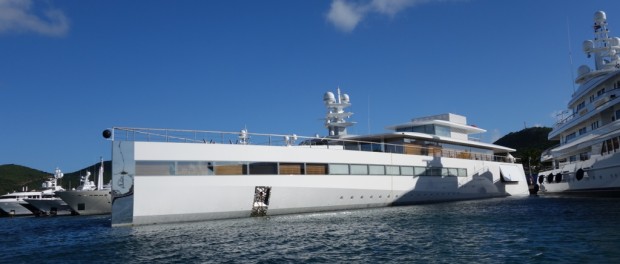
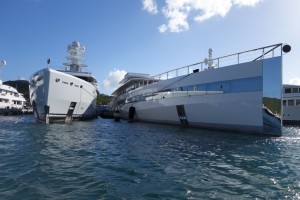
Leave a comment